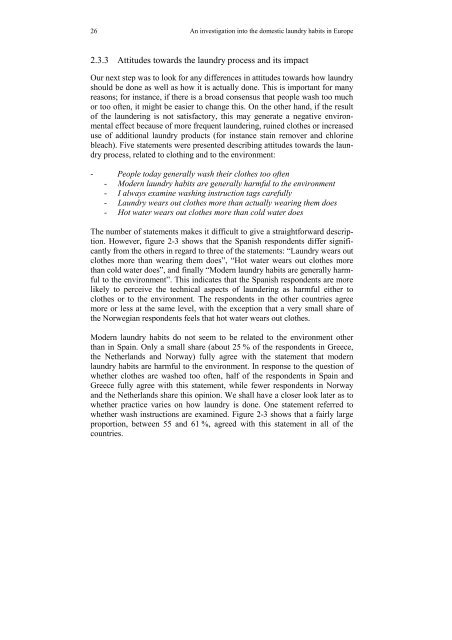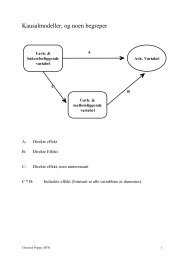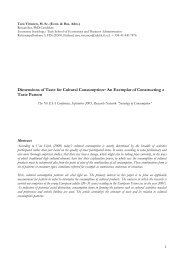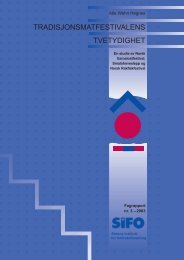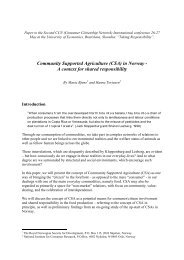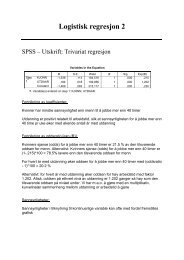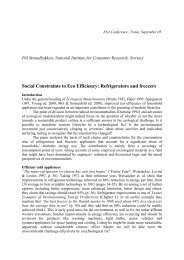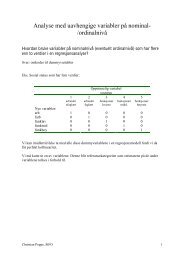an investigation of domestic laundry in europe - habits ... - SIFO
an investigation of domestic laundry in europe - habits ... - SIFO
an investigation of domestic laundry in europe - habits ... - SIFO
Create successful ePaper yourself
Turn your PDF publications into a flip-book with our unique Google optimized e-Paper software.
26An <strong><strong>in</strong>vestigation</strong> <strong>in</strong>to the <strong>domestic</strong> <strong>laundry</strong> <strong>habits</strong> <strong>in</strong> Europe2.3.3 Attitudes towards the <strong>laundry</strong> process <strong>an</strong>d its impactOur next step was to look for <strong>an</strong>y differences <strong>in</strong> attitudes towards how <strong>laundry</strong>should be done as well as how it is actually done. This is import<strong>an</strong>t for m<strong>an</strong>yreasons; for <strong>in</strong>st<strong>an</strong>ce, if there is a broad consensus that people wash too muchor too <strong>of</strong>ten, it might be easier to ch<strong>an</strong>ge this. On the other h<strong>an</strong>d, if the result<strong>of</strong> the launder<strong>in</strong>g is not satisfactory, this may generate a negative environmentaleffect because <strong>of</strong> more frequent launder<strong>in</strong>g, ru<strong>in</strong>ed clothes or <strong>in</strong>creaseduse <strong>of</strong> additional <strong>laundry</strong> products (for <strong>in</strong>st<strong>an</strong>ce sta<strong>in</strong> remover <strong>an</strong>d chlor<strong>in</strong>ebleach). Five statements were presented describ<strong>in</strong>g attitudes towards the <strong>laundry</strong>process, related to cloth<strong>in</strong>g <strong>an</strong>d to the environment:- People today generally wash their clothes too <strong>of</strong>ten- Modern <strong>laundry</strong> <strong>habits</strong> are generally harmful to the environment- I always exam<strong>in</strong>e wash<strong>in</strong>g <strong>in</strong>struction tags carefully- Laundry wears out clothes more th<strong>an</strong> actually wear<strong>in</strong>g them does- Hot water wears out clothes more th<strong>an</strong> cold water doesThe number <strong>of</strong> statements makes it difficult to give a straightforward description.However, figure 2-3 shows that the Sp<strong>an</strong>ish respondents differ signific<strong>an</strong>tlyfrom the others <strong>in</strong> regard to three <strong>of</strong> the statements: “Laundry wears outclothes more th<strong>an</strong> wear<strong>in</strong>g them does”, “Hot water wears out clothes moreth<strong>an</strong> cold water does”, <strong>an</strong>d f<strong>in</strong>ally “Modern <strong>laundry</strong> <strong>habits</strong> are generally harmfulto the environment”. This <strong>in</strong>dicates that the Sp<strong>an</strong>ish respondents are morelikely to perceive the technical aspects <strong>of</strong> launder<strong>in</strong>g as harmful either toclothes or to the environment. The respondents <strong>in</strong> the other countries agreemore or less at the same level, with the exception that a very small share <strong>of</strong>the Norwegi<strong>an</strong> respondents feels that hot water wears out clothes.Modern <strong>laundry</strong> <strong>habits</strong> do not seem to be related to the environment otherth<strong>an</strong> <strong>in</strong> Spa<strong>in</strong>. Only a small share (about 25 % <strong>of</strong> the respondents <strong>in</strong> Greece,the Netherl<strong>an</strong>ds <strong>an</strong>d Norway) fully agree with the statement that modern<strong>laundry</strong> <strong>habits</strong> are harmful to the environment. In response to the question <strong>of</strong>whether clothes are washed too <strong>of</strong>ten, half <strong>of</strong> the respondents <strong>in</strong> Spa<strong>in</strong> <strong>an</strong>dGreece fully agree with this statement, while fewer respondents <strong>in</strong> Norway<strong>an</strong>d the Netherl<strong>an</strong>ds share this op<strong>in</strong>ion. We shall have a closer look later as towhether practice varies on how <strong>laundry</strong> is done. One statement referred towhether wash <strong>in</strong>structions are exam<strong>in</strong>ed. Figure 2-3 shows that a fairly largeproportion, between 55 <strong>an</strong>d 61 %, agreed with this statement <strong>in</strong> all <strong>of</strong> thecountries.


